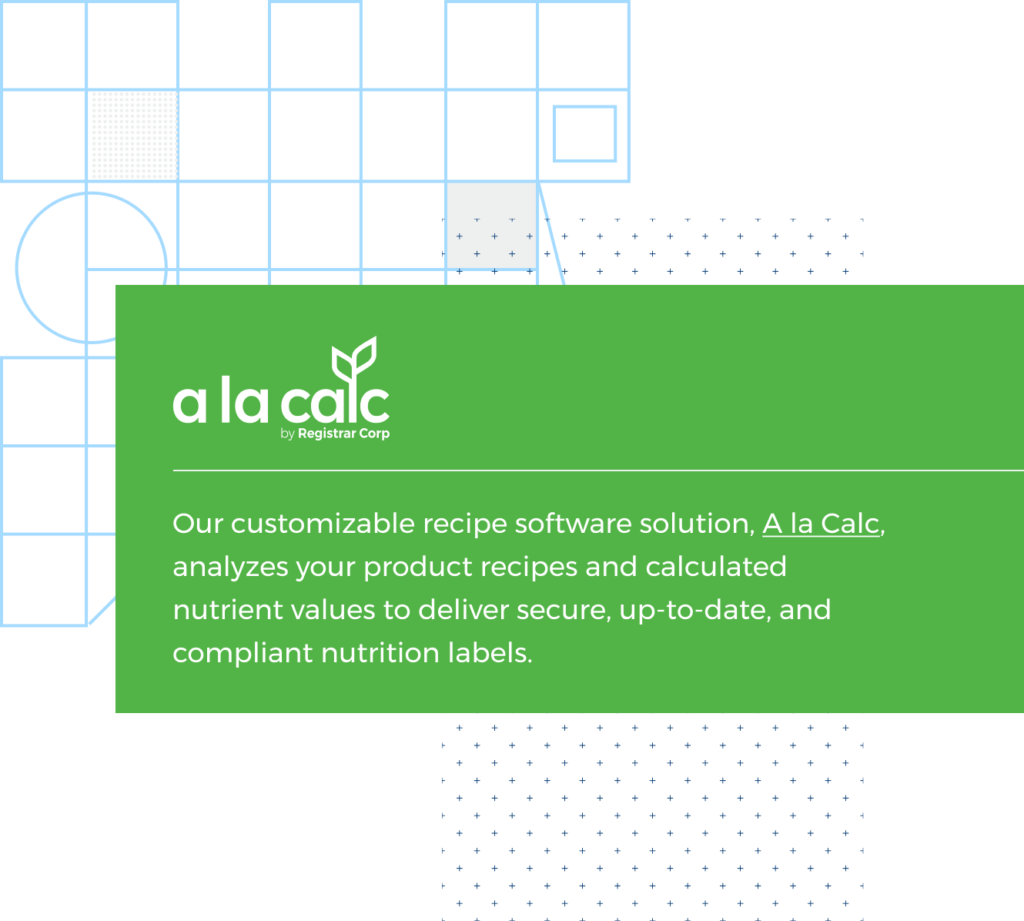Complying with FDA labeling requirements is simple with our Label Review solutions.
Our FDA label, product, and ingredient professionals help thousands of companies assure their products in the food and beverage, cosmetic, drug, medical device, dietary supplement, and animal feed industries meet FDA labeling requirements.

Registrar Corp’s Labeling and Ingredients Review Service includes:

A free assessment of your product’s label

A review of your product ingredients to determine if they are appropriate for the U.S. market

A detailed report of recommended
revisions to your label

One additional set of revisions to the revised label within 30 days

A ready-to-use graphic file of your FDA-compliant label

One-on-one expert assistance from a Regulatory Specialist
Food, Beverage, and Dietary
Supplement Labeling And
Ingredients Review
Remaining compliant with FDA labeling regulations is an ongoing process. In 2016, FDA finalized significant changes to food, beverage, and supplement labeling, including updates to daily values, serving sizes, the nutrition facts chart, and more. The compliance deadline for these rules was January 1, 2020, or January 1, 2021 for manufacturers with less than 10 million in annual sales. Since January 2021, FDA has enforced its new labeling requirements on products being marketed in the U.S.
Full-Service Product Label Review
Our team cross references your label against thousands of pages within the Code of Federal Regulations, the Federal Register, Substances Added to Food database, GRAS notices, guidance documents, labeling guides, and Warning Letters issued by FDA to research that your label is compliant for:
- Statement of Identity: Evaluation for common name, any applicable standards of identity, flavor declaration requirements, and more
- Nutrition Facts or Supplement Facts: Includes evaluation for any exemptions for which the product qualifies; Review will determine if any modified format (such as simplified and tabular) may be used for the product
- Ingredients: Evaluation of a product’s ingredients to ensure that they are generally recognized as safe (GRAS) or approved by FDA as a color additive or food additive; modification as necessary to ensure that ingredients are declared properly according to FDA’s requirements; Dietary supplement ingredients are reviewed to determine if they may be subject to the New Dietary Ingredient notification requirement
- Claims Review: Evaluation of any nutrient content claims (e.g., “high in potassium”), health claims, or structure/function claims found on the label
- Net Quantity of Contents
- Allergen declaration as required under the Food Allergen and Labeling Consumer Protection Act (FALCPA)
- Manufacturer/Packer/Distributor statement
- Country of Origin required by U.S. Customs and Border Protection
- Bioengineered Disclosure statement as required by the U.S. Department of Agriculture
- Any other information found that could be subject to FDA jurisdiction
Nutrition Facts Label Review
If you only require assistance reviewing your nutrition facts label, Registrar Corp’s Regulatory Specialists can assist you in creating a compliant nutrition facts label. This simplified service includes:
- Evaluation of product to determine the appropriate RACC
- Proper serving size determination per FDA regulations
- FDA-compliant nutrition facts label
- Evaluation of product packaging and size to determine if any modified formats may be required (e.g., column formats)
Select “Nutrition Facts Label Only” in the form below to take advantage of this service.

Drug Labeling and Ingredients Review
The FDA requires Over The Counter (OTC) drug labels to list active ingredients, drug uses, warnings, and dosage instructions. Registrar Corp will review your labels’ ingredients, language, and instructions and include a current list of FDA regulations, compliance guides, warning letters, import alerts, and other documents in your report.
Medical Device Labeling and Product Review
FDA has labeling regulations that apply to all medical devices, from toothbrushes to ultrasound machines. Your device’s label may need to include adequate instructions for use, warning statements, Unique Device Identifiers, or any information necessary for user safety. Registrar Corp can review your device’s current label and modify it to incorporate FDA’s labeling requirements.


Cosmetic Labeling and Ingredient Review
The Federal Food, Drug, and Cosmetic Act (FFDCA) prohibits any distribution of misbranded cosmetic products. Misbranding can refer to false or misleading labeling claims, labels with missing information, or containers made or filled in a deceptive manner. With Registrar Corp, you’ll receive targeted feedback on your cosmetics labels and thorough compliance guidance.
Animal Feed and Pet Food Labeling and Ingredient Review
FDA works with the Association of American Feed Control Officials (AAFCO) to establish labeling regulations and determine appropriate ingredients for animal feed, pet food, and supplements. Our team can review your product’s label and ingredients and assure their compliance with FDA and AAFCO guidelines.


Color Additive Review and Batch Certification
FDA regulates color additives intended for use in food, medical devices, drugs, and cosmetics. Some colors are approved generally, while others have specific approved uses or limitations on their use, and some require “batch certification” before they can be added to a finished product. Registrar Corp’s regulatory experts can help you navigate FDA’s extensive color additives regulations and determine which requirements apply to your products.
California Safe Cosmetics Act Reporting
Certain cosmetic companies intending to sell in the U.S. state of California are required to report ingredients in their products that may cause cancer, birth defects, or other reproductive harm. Registrar Corp helps companies determine which ingredients in their products may be subject to this requirement and reports them to California.

Make sure your product labels and ingredients are compliant.
Frequently Asked Questions
FDA has authority over many of the products people use every day, such as food, dietary supplements, cosmetics, drugs, animal feed, and medical devices. Generally, labels must be truthful and not misleading, to prevent being deemed misbranded (and subject to enforcement action by FDA). This applies to products manufactured domestically as well as products manufactured outside of the U.S. and imported.
Regulations in Title 21 of the Federal Code of Regulations require that specific statements appear on these products’ labeling. FDA has also published many guidance documents to assist industries in understanding the regulations and how FDA will apply them.
The core requirements for foods include the declaration of a statement of identity, net quantity of contents, nutrition facts information, ingredients list, and the identity of the manufacturer, packer, or distributor. FDA’s regulations and guidance documents also offer specific content and formatting requirements, like mandatory type size and how ingredients should be named. The “Nutrition Facts” panel has additional graphic elements (i.e., the chart) that must be used on the labeling.
FDA’s new rules came into effect for all firms on January 1, 2021. All food products bearing nutritional information must now show the updated version of the Nutrition Facts label.
Certain products (such as ice cream, jam, and mixed nuts) are subject to “standards of identity,” or regulations that describe conditions that a product must meet to be called by a certain name. These may include required or prohibited ingredients, specific manufacturing processes, or certain characteristics (such as milkfat percentage).
FDA publishes regulations for standard of identity and issues guidance documents for naming other types of products, such as chocolate, foods with foreign names, spices, and seafood.
Many of the same labeling requirements for conventional foods also apply to dietary supplements, with a few notable exceptions. Instead of a “Nutrition Facts” panel, supplements must declare a “Supplement Facts” panel that has very different formatting and content. Supplements must also include a domestic U.S. phone number and mailing address so consumers can report serious adverse events.
Any claims being made that reference the structure or function of the body must be accompanied by a disclaimer statement: “This statement has not been evaluated by the Food and Drug Administration. This product is not intended to diagnose, treat, cure, or prevent any disease.” This disclaimer also has its own type size, formatting, and placement requirements.
Cosmetic products are subject to labeling regulations issued by FDA and the Fair Packaging and Labeling Act (“FPLA”). Cosmetic labels must declare a statement of identity, net quantity of contents, ingredients list, and the identity of the manufacturer, packer, or distributor. Cosmetic labeling regulations also include many requirements for type size, content, and format.
It’s extremely important for companies marketing cosmetics to pay close attention to the claims being made on the labels of their products. Cosmetics may only make claims to cleanse, beautify, or alter the appearance in a superficial way. Any claim that implies an effect on the structure or function of the body or references a disease can cause the product to be branded a drug by FDA, even if there are no active pharmaceutical ingredients.
In December 2022, U.S. Congress passed the Modernization of Cosmetics Regulation Act (“MoCRA”) which drastically increased the requirements for cosmetic products. It includes new labeling requirements for fragrance allergens and an adverse event reporting contact. It also now requires certain facilities to register and/or list their products with FDA.
By FDA’s definition, a drug is any product that is “intended for use in the diagnosis, cure, mitigation, treatment, or prevention of disease” and “(other than food) intended to affect the structure or any function of the body.” Any product that meets that definition can be regulated by FDA as a drug. As a result, many products commonly marketed as cosmetics may be regulated by FDA as drugs, such as sunscreens, acne treatment products, fluoride toothpastes, and chapped skin creams.
Drugs must either meet the requirements of a final order (monograph) or be approved by FDA through the New Drug Application (“NDA”) process. Monographs specify active ingredients that are permitted for a particular drug category and require specific statements be included in the labeling. Generally, drug labels require a statement of identity, net quantity of contents, “Drug Facts” panel, U.S. phone number or mailing address for serious adverse event reporting, and the identity of the manufacturer, packer, or distributor. Labeling requirements can be found in Title 21 of the Federal Code of Regulations, guidance documents issued by FDA, and the monograph for that particular drug category.
Drug products are also subject to registration and product listing requirements before they can be marketed in the U.S.
FDA has jurisdiction over animal feed, which includes pet food and supplement products. The agency works with the Association of American Feed Control Officials (“AAFCO”), a voluntary membership organization of U.S. state and federal government agencies that govern the production, labeling, distribution, use, and sale of animal feed.
FDA labeling requirements include a statement of identity, net quantity of contents, ingredients list, and identity of the manufacturer, packer, or distributor. Pet food labels are usually supplemented by requirements specified by AAFCO in their Official Publication (“OP”). These include individual state requirements such as a “Guaranteed Analysis,” purpose statements, and additional limitations on the types of claims that can be made in reference to a product or its ingredients.
Medical device labeling regulations will require a statement of identity and net quantity of contents for over-the-counter (“OTC”) products. All medical devices (including prescription devices) should declare intended use, adequate directions for use, contraindications and warnings, and unique device identifier (“UDI”). Prescription devices must also bear an additional statement or symbol identifying themselves as such.
Medical device labeling regulations are designed to apply to both simple products such as a scalpel and complex products like ultrasound machines, which means they can vary widely. In addition to the general labeling regulations, companies should research any specific guidance documents that FDA may have for their exact device, to assure that all mandatory or recommended statements are included.
Ingredient regulations can vary widely from market to market. Ingredients considered acceptable outside the U.S. may not have the same status with FDA. One important example of this is color additives. Color additive violations are common, as FDA requires that every color additive (even naturally sourced ones) be approved by them.
Conventional food ingredients must either be approved as food additives or be generally recognized as safe (“GRAS”) for their intended use. Dietary ingredients found in supplements are exempt from this requirement but are subject to a “new dietary ingredient notification” requirement if they were not marketed in a supplement in the U.S. prior to October 15, 1994.
Except for color additives, cosmetic ingredients are not approved by FDA. Manufacturers are required to ensure that the ingredients found in their products are safe for their intended use. The Modernization of Cosmetics Regulation Act of 2022 imposes additional requirements for safety substantiation on manufacturers of cosmetic products, but no authority has been granted to FDA to formally approve other types of cosmetic ingredients.
The active ingredients found in over-the-counter (“OTC”) drugs must be generally recognized as safe and effective (“GRASE”) and included in a published monograph or be the subject of a New Drug Application (“NDA”) or Abbreviated New Drug Application (“ANDA”). Like cosmetic ingredients, inactive ingredients in OTC drugs are not approved by FDA, except for color additives. Manufacturers should ensure that they are appropriate and safe for their intended use, the category of drug in which they are used, and the formulation of the product itself.
Companies should conduct a thorough review of the ingredients found in all products they intend to market in the U.S. Inappropriate or illegal ingredients can result in a shipment being detained at port of entry. The importer must then either re-export or destroy the product, which can cause significant supply chain disruptions and financial losses. Registrar Corp’s Label Review Service includes an analysis of the product ingredients to ensure that they are permitted in the U.S. market.
Permitted claims depend upon your product category (e.g., food, supplement, drug). Conventional food and dietary supplement products may make claims about levels of certain nutrients in the product, the effects on the structure and function of the body, certain disease risk reduction claims, and characteristics such as “gluten free” or “healthy.”
Acceptable cosmetic claims are much more limited since they can only claim to beautify and alter appearance in a superficial way. Claims made on drug products or medical devices will depend on the intended use that is described in the monograph or device classification.
Most claims are also subject to limitations described in the Code of Federal Regulations, FDA guidance documents, or other publications. Nonpermitted claims can result in product detention on misbranding or unapproved drug charges.


